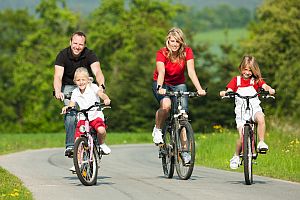Want Your Kids to Be Active? Here Is Why YOU Should Be their Lifestyle Role Model

It’s not news—obesity is a growing national epidemic among young people. The Centers for Disease Control and Prevention (CDC) estimate that obesity in children has doubled in the last 30 years and quadrupled in adolescents. Nearly 20% of children 6-11 years old are obese as are almost 23% of teenagers. This places them at increased risk of developing cardiovascular disease, diabetes, bone and joint problems, sleep apnea, type 2 diabetes, stroke, several types of cancer, and osteoarthritis. Finally—and even more concerning—studies have shown that people who are obese as children tend to be obese as adults.
What’s happening here? In large part, it comes down to our lifestyle choices. Record numbers of both adults and children are succumbing to the temptations of TV, computers, and video games, and many of us simply don’t get the exercise our bodies need to stay healthy.
Naturally, parents who read statistics like these may be—and should be—concerned about their kids. More and more often, they ask themselves questions like “What can we do to help our kids be more active and physically fit?” One answer to this question is pretty simple: To get your kids to be more active, engage in more active pursuits with them. One of the keys to getting children to exercise more is to have them see their parents exercise more. That’s the finding from a new study published in the journal Pediatrics
In the study, researchers at the University of Cambridge School of Clinical Medicine in England fitted 554 mother-child pairs with equipment to measure how much exercise they were getting when they were together as well as when they were apart. Accelerometers tracked their exercise levels, and GPS devices measured how close they were to each other. Over the course of seven days, the findings were clear – the more physical activity the mother was engaged in while with the child, the more active the child was during the rest of the day. In fact, for every minute of moderate-to-vigorous activity the mother got, the child was likely to get ten percent more of the same activity. Conversely, for every minute the mother was sedentary, the child was 0.18 minutes more sedentary. Both of these effects were more pronounced in girls than in boys.
These findings seem to indicate that parents can be effective role models for their children by getting more active exercise themselves. But specialists emphasize that parents don’t have to drop their other priorities to do this. Physical therapist Teresa Beckman suggests, “Incorporate small changes into your daily life. For example, rather than playing a board game together, go outside and play hopscotch. Or if you’re planning a trip to your local playground, try walking instead of driving.”
Other suggestions for becoming more active with your children include playing more sports with them, walking more with them (if you take the bus, get off one or two stops early and walk the rest of the way), riding bikes together, and even playing Frisbee. Dancing is good exercise, so you can encourage your kids to take lessons in various forms of dance and then set a good example for them by attending the classes yourself. You can join exercise classes together, schedule regular pre-dinner walks or runs, or just play family games of basketball or soccer.
You are your child’s most important role model when it comes to teaching them about the importance of exercise. And exercising together is just as good for you as it is for them. So switch off that TV or computer and go out to play! You’ll both be doing something good for your health and having fun at the same time!







 Behind many of the debates about healthcare in the US—its availability and cost as well as its effectiveness—is an important phenomenon. The demands being placed on healthcare providers are growing and changing (at least in large part) because of the way we live our lives. Day-to-day choices we all make are contributing to a wide variety chronic health conditions that are sometimes referred to as “lifestyle diseases.” And while our healthcare system is very good at treating acute medical problems, it is not very good at preventing or treating chronic ones.
Behind many of the debates about healthcare in the US—its availability and cost as well as its effectiveness—is an important phenomenon. The demands being placed on healthcare providers are growing and changing (at least in large part) because of the way we live our lives. Day-to-day choices we all make are contributing to a wide variety chronic health conditions that are sometimes referred to as “lifestyle diseases.” And while our healthcare system is very good at treating acute medical problems, it is not very good at preventing or treating chronic ones.